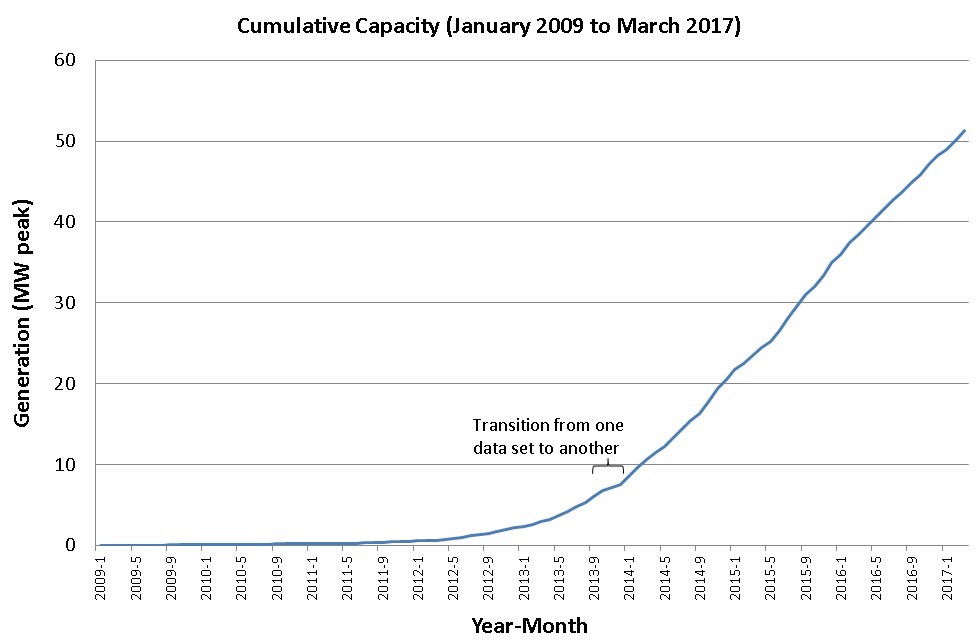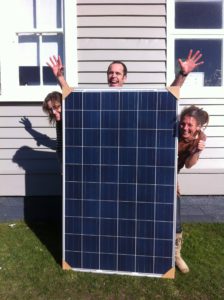It costs households more and it is hard to justify on environmental grounds (in a country that already gets 80% of its electricity from renewable sources). But New Zealanders are installing solar PV like never before. How to make sense of this seemingly irrational behaviour?
CIED Visiting Fellow Dr Janet Stephenson sheds some light on the issue.
************************************************************************************************************************************************************************************************************************
Over the past decade or so, many nations have introduced feed-in tariffs or other subsidies to encourage households and businesses to install solar generation. The predominant reason for such policies has been to grow the proportion of renewable electricity generation, thereby reducing greenhouse gas emissions. These policies have by and large been effective, with significant uptake of PV in many regions where PV would not otherwise have been an economically rational proposition. Even in sun-constrained UK, for example, solar generation now contributes around 3.4% of total electricity consumption.
But what about a country which already has high levels of renewable generation? Should solar generation be encouraged there too?
This is a hot topic in New Zealand.
New Zealand already gets 80% of electricity from renewable sources
Over 80% of electricity generation in New Zealand has been from renewable sources for the past few years (from hydro, geothermal and wind). The government’s energy policies have given little attention to PV as a potentially significant contributor to New Zealand’s future energy mix. There has been no political interest (apart from the Greens) in introducing PV subsidies, although environmental NGOs have been calling for PV feed-in tariffs for years. The deeply embedded neoliberal stance of successive governments means a reluctance to introduce subsidies for anything but the most intractable problems (subsidies for household ceiling and floor insulation being a rare example).
Solar PV is being actively discouraged by the government and energy companies
More than this, there has been active discouragement of PV uptake within the energy sector. For example, electricity retailers routinely pay households far less for feeding surplus generation back into the grid than they charge those households for purchasing from the grid – the effect being the opposite of a feed-in tariff. Even more contentiously, one of the larger electricity distribution companies has recently introduced what NGOs and PV installers are calling a ‘solar tax’ – an extra lines charge to customers who install PV.
Discouragement has also been actively (and contentiously) promulgated in the media as a result of work commissioned by the government-established and industry-supported Smart Grid Forum. The argument put forward by the consultants who produced the report is that PV is currently not a good option for New Zealand for several reasons: it does not stack up economically (the marginal cost of PV being higher than the marginal cost of wind, for example); if it becomes widespread it may require more thermal generation to fill in for winter peaks than would otherwise be the case; and also that solar would result in more emissions than other forms of renewable generation. The Parliamentary Commissioner for the Environment has similarly argued that PV does little to reduce New Zealand’s carbon footprint, unlike countries with carbon-intensive generation. The government’s Electricity Authority has made the argument that, given wealthier people are more likely to install PV, poorer people will end up paying more for their electricity. And the Energy Efficiency and Conservation Authority (EECA), another government agency, has frequently stated their preference for New Zealanders to invest in electric vehicles rather than PV, pointing out that the emissions reduction from EVs is far more environmentally beneficial. All of which is true.
Kiwis are installing PV at quite a rate
So in the face of such discouragement, what are Kiwis doing?
They are being perverse. As the figure below shows, they are installing PV at quite a rate. Between 2013 and 2014 the installed capacity increased by 144%; and the following two years increased by 59% and 40% respectively. This is in a similar ballpark (albeit far smaller total figures) to the UK where the subsidy-supported increase was 90% between 2013-14, and the following years 70% and 27%. Installed capacity of PV in New Zealand was 52.5 MW as at the end of April 2017 (45 MW of this being residential) with solar generation being around 0.1% of New Zealand’s total generation. It is a drop in the bucket compared to the UK at this point, let alone high-uptake nations like Germany and Australia, but it could be the start of something much bigger.

Source: Dr Allan Miller, GREEN Grid research programme, University of Canterbury, New Zealand
Why is this happening? Looking at the graph it is clear that something happened around 2012, which we believe is probably to do with PV falling to a price which meant it was no longer the sole realm of the very rich or the very committed. But PV did not reach price parity at that time, and for most New Zealand households it still hasn’t.
Kiwis just like the idea of PV
It seems that Kiwis just like the idea of PV. They are choosing to install it even though it may be neither an economically rational decision at a personal level (e.g. the net present value may be more than purchasing from the grid) nor an environmentally rational decision (e.g. the GHG emissions from a life cycle assessment of installed PV is greater than that of wind generation). They are choosing to install it even where they are gouged by their retailer if they feed back into the grid, and where they are aware of vociferous pushback by the energy sector.
Kiwis have a hunger to self-generate their electricity. Our 2014 national survey household survey (as part of the Energy Cultures research project) found that around 50% of New Zealand householders would ideally like to generate their own electricity: 17% would like to be independent of the grid and generate all their own electricity, and another 32% would prefer to supplement their electricity supply with their own generation. These results are very similar to our 2012 survey results from the same question, so we believe that this is an established appetite. Of course, this does not mean that all 50% will end up installing PV, but it does indicate a considerable market should the cost of PV continue to tumble.
This is why the energy industry is concerned.
When we have interviewed householders about why they are interested in PV, the strongest theme is independence. They despise their energy companies; they are tired of ongoing power price increases; and/or they want control over their expenditure – especially if they are heading towards retirement. Other reasons include wanting greater resilience in the face of natural disasters, being keen on new technology for its own sake, and a liking of renewable generation. For many, the precise financial cost/benefit analysis is unimportant – they are adopting for other reasons. However for many of those who have not yet adopted, the upfront cost is the greatest barrier, but with falling prices this barrier is getting lower all the time.
So despite PV uptake perhaps not being in the national interest, or in the interest of electricity utilities, it is seen by households as being in their interest. And the barriers to uptake are melting.
It is no wonder that the electricity industry is worried. Depending on how quickly PV prices fall, there could be a rapid and significant shift in the locus of electricity generation, raising issues for the technical management of power flows as well as the financial viability of their current business models.
Some companies are starting to join in
Some utilities are actively pushing back to try to discourage it, as with the ‘solar tax’ example. Some are trying to pretend it is not happening. The more progressive are joining in: New Zealand’s largest distribution company Vector, for example, is playing to the consumer interest by offering solar installations (including lease or lease-to-buy options) and battery storage to its customers.
Strategic players know that a sea change is coming whether they want it or not, due to rapid advances in technologies and falling prices of PV and battery storage. The CEO of Transpower (the government agency with oversight of the high-voltage transmission system) in releasing their planning document Transmission Tomorrow in 2016 made it clear that the growth of solar and other distributed renewables over coming decades meant that the function of the grid was likely to shift by 2040 to a primary role of storage and maintaining system resilience, rather than its current primary role in unidirectional delivery of electrons.
It is an interesting story from a socio-technical perspective. Here we have a country where PV is actively discouraged, and probably doesn’t make that much sense (at this point in time) if rationally considered, and yet is rapidly taking off, underpinned by a massive latent appetite. The changing energy culture of New Zealand households is threatening to disrupt, and potentially transform, the incumbent regime.

“The Blueskin Resilient Communities Trust (pictured) is one of many grassroots initiatives in New Zealand that combines energy advocacy and community development.”
As for poorer households? So far, that is a question that has been left hanging.
The wider question, which is already of concern to electricity industry incumbents worldwide, is whether the widespread uptake of PV will lead to a radical reshaping of the electricity sector and a shift in the locus of control of energy systems.
By the way, this isn’t an argument against subsidies. Feed-in tariffs and other policy support have been invaluable globally in kick-starting growth in the solar industry, stimulating innovation, and building expertise. But a future when subsidies will be no longer required to make solar generation a financially viable option for most consumers is getting closer all the time. Solar was recently reported to be the least cost option for generation in Denmark, Egypt, India, Mexico, Peru and the United Arab Emirates for 2016. The New Zealand story, with its consumer-driven uptake, may offer insights into the characteristics of a subsidy-free market, people’s motivations to invest in PV, and the pushback by those who benefit from the current regime.
*******************************************************************************************************************************************************************************************************
Responses welcome to janet.stephenson@otago.ac.nz
Dr Janet Stephenson is the Director of Centre for Sustainability, University of Otago, New Zealand.
For a discussion of some of these issues, see: Ford, R., Walton, S., Stephenson, J., Rees, D., Scott, M., King, G., Williams, J., & Wooliscroft, B. (2017). Emerging energy transitions: PV uptake beyond subsidies. Technological Forecasting and Social Change. 117, 138-150
********************************************************************************************************************************************************************************************************
For more information on CIED’s work on Housing and Buildings, please click here.